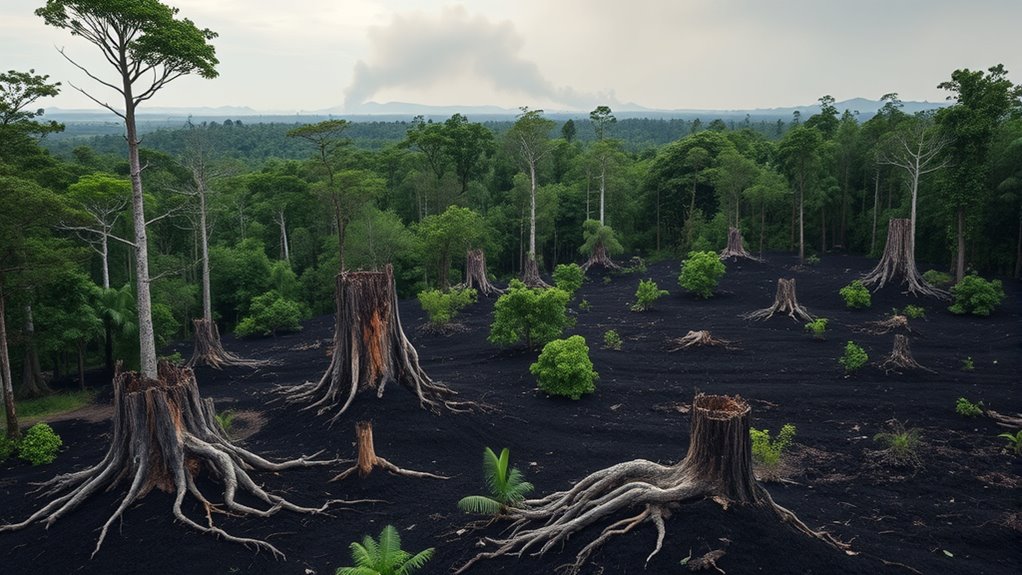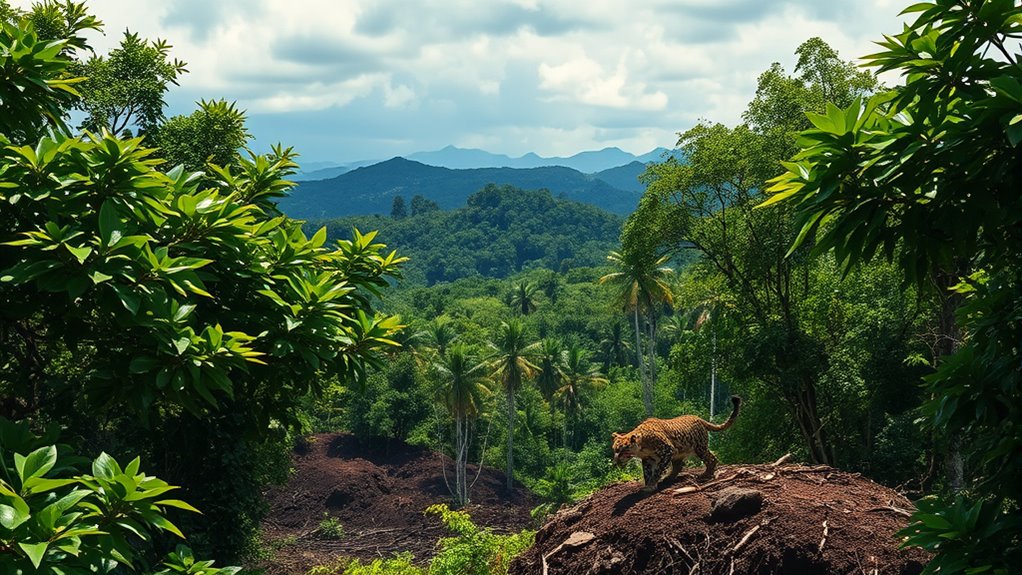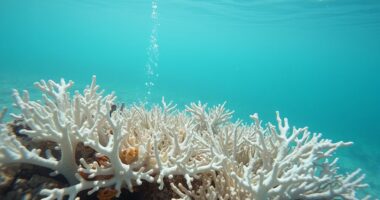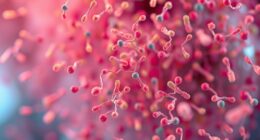Biodiversity loss happens mainly because of habitat fragmentation and invasive species. Human activities like urbanization and agriculture break habitats into smaller patches, making it tough for native plants and animals to survive. Invasive species outcompete locals, alter ecosystems, and reduce native populations. These issues weaken ecosystems worldwide, risking extinction for many species and disrupting essential ecological processes. If you want to understand how these factors impact the planet and what we can do, keep exploring further.
Key Takeaways
- Habitat fragmentation reduces available resources and genetic diversity, leading to species decline and increased extinction risks.
- Invasive species outcompete native populations, disrupt ecosystems, and cause biodiversity loss worldwide.
- Human activities like urbanization and agriculture accelerate habitat destruction and fragmentation.
- Loss of biodiversity diminishes ecosystem resilience, affecting services such as pollination, water purification, and climate regulation.
- Conservation efforts focus on protecting large habitats and reducing invasive species to mitigate global biodiversity decline.

Have you ever wondered what happens when the variety of life on Earth begins to disappear? One of the main causes of biodiversity loss is habitat fragmentation. This occurs when large, continuous habitats are broken into smaller, isolated patches, often due to human activities like urban development, agriculture, and infrastructure projects. When habitats become fragmented, the species that rely on them lose access to essential resources such as food, water, and breeding sites. This isolation can lead to reduced genetic diversity because populations become smaller and more separated, making it harder for species to adapt to environmental changes or recover from disturbances. As habitats shrink, some species may not survive the changeover, and others may struggle to find mates or establish territories, leading to declines or extinctions. Habitat fragmentation also impairs ecological processes like pollination and seed dispersal, which further destabilizes ecosystems. Additionally, environmental stress from extreme temperatures and pollution can exacerbate the vulnerabilities of isolated populations.
In addition to habitat fragmentation, invasive species play a significant role in biodiversity loss. These are non-native plants, animals, or microbes introduced into new environments, either intentionally or accidentally. Invasive species often outcompete native species for resources, such as food and habitat space, because they tend to have few natural predators or diseases in their new environments. This imbalance can cause native populations to decline rapidly or even disappear. For example, invasive plants can alter soil chemistry and hydrology, making the environment unsuitable for native plants, while invasive predators can decimate local animal populations. The introduction of invasive species is often linked to globalization, trade, and travel, which facilitate the movement of species across borders. Once established, invasive species can reshape entire ecosystems, reducing biodiversity and diminishing ecological resilience.
Both habitat fragmentation and invasive species create a cascade of negative effects that threaten the stability of ecosystems worldwide. As habitats become more fragmented, native species face increased risks of extinction, and invasives can exploit these vulnerabilities to establish dominance. When these factors combine, they accelerate biodiversity loss and weaken the natural systems that sustain life. This loss isn’t just about losing individual species; it impacts the entire web of life, affecting human well-being, agriculture, and the services ecosystems provide, like clean water, air, and climate regulation. Recognizing the interconnectedness of habitat fragmentation and invasive species is essential for developing effective conservation strategies. By protecting large, intact habitats and preventing the spread of invasive species, you help preserve the rich tapestry of life on Earth, ensuring its resilience for future generations. Also, understanding Vegan principles can promote sustainable alternatives that reduce environmental pressures contributing to habitat destruction.
Frequently Asked Questions
How Does Biodiversity Loss Affect Human Health?
Biodiversity loss impacts your health by disrupting ecosystem services like clean air, water, and food supply. When species decline, disease regulation weakens, increasing your risk of zoonotic diseases and outbreaks. You may notice more allergies, respiratory issues, or food insecurity. Protecting biodiversity helps maintain these essential services, ensuring a healthier environment for you and future generations. So, conserving biodiversity directly supports your well-being and resilience against health threats.
What Are the Economic Costs of Biodiversity Decline?
Imagine losing the backbone of our natural world—you face hefty costs. The decline of biodiversity hits the economy hard, as ecosystem services like pollination, water purification, and climate regulation weaken. You can’t ignore these losses; they’re like torn pages from life’s book. Economic valuation helps quantify this damage, revealing how much it costs you and society when nature’s balance tips. Protecting biodiversity is an investment in economic stability.
Can Biodiversity Loss Be Reversed or Restored?
You can reverse or restore biodiversity loss through various restoration techniques, like reforestation, habitat rehabilitation, and invasive species control. These efforts help boost ecosystem resilience, making habitats more robust against future threats. By actively engaging in conservation projects and supporting policies that protect natural areas, you contribute to restoring biodiversity, ensuring healthier ecosystems for future generations. Restoration isn’t always immediate, but persistent efforts can profoundly improve ecosystem health over time.
How Do Climate Change and Biodiversity Loss Interact?
Oh, what a surprise—climate change and biodiversity loss are best friends, making each other worse. You see, climate feedbacks accelerate warming, undermining ecosystem resilience. As habitats vanish, ecosystems weaken, making it harder for species to adapt or recover. So, your actions now impact this vicious cycle, with declining biodiversity reducing nature’s ability to buffer climate impacts, creating a downward spiral where both issues amplify each other, and everyone loses.
What Policies Effectively Prevent Biodiversity Decline?
You can prevent biodiversity decline by supporting policies that establish protected areas and promote sustainable practices. These policies help conserve habitats and species, reducing human impact. By advocating for the expansion of protected areas and encouraging industries to adopt sustainable methods, you directly contribute to safeguarding biodiversity. Effective policies balance development with conservation, ensuring ecosystems remain healthy and resilient for future generations.
Conclusion
If you ignore the signs already around you, the consequences could be unimaginable. Biodiversity loss isn’t just about disappearing species; it’s about the fragile balance of life itself unraveling. The future depends on your actions today—will you stand by or take a stand? The choices you make now could determine whether our planet’s rich tapestry of life continues or quietly disappears. The question is, are you willing to risk what’s at stake?









